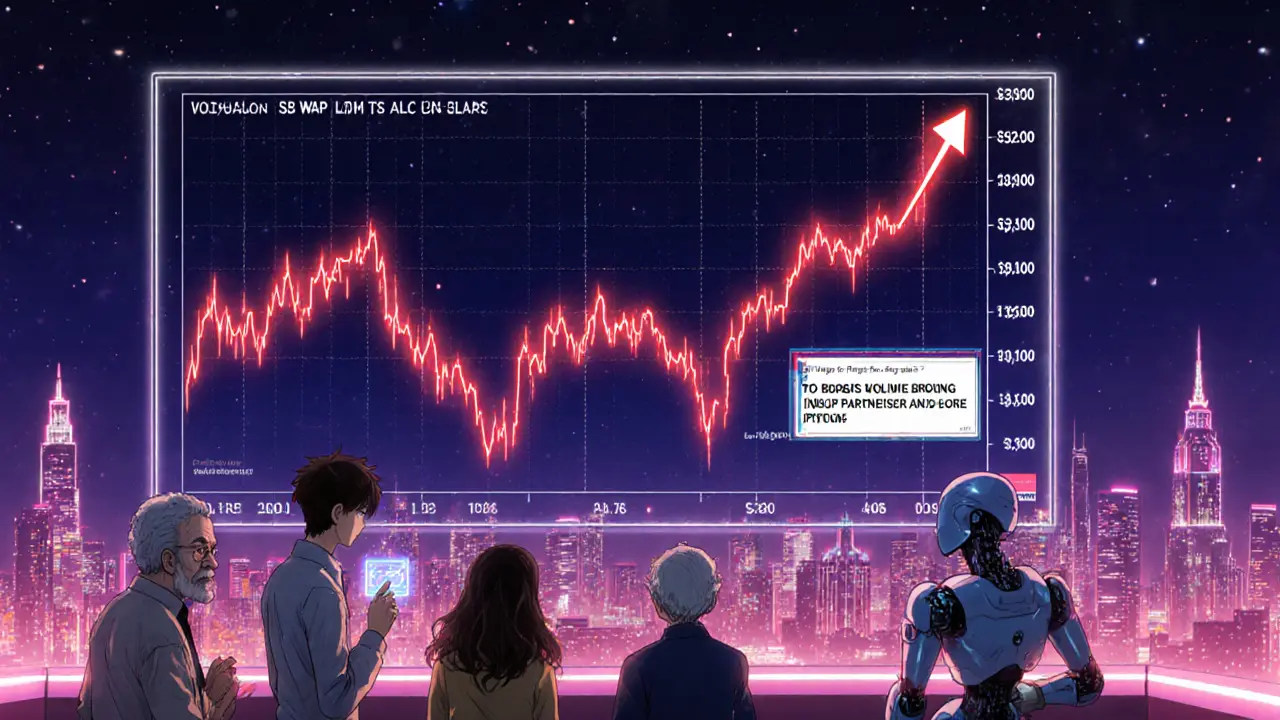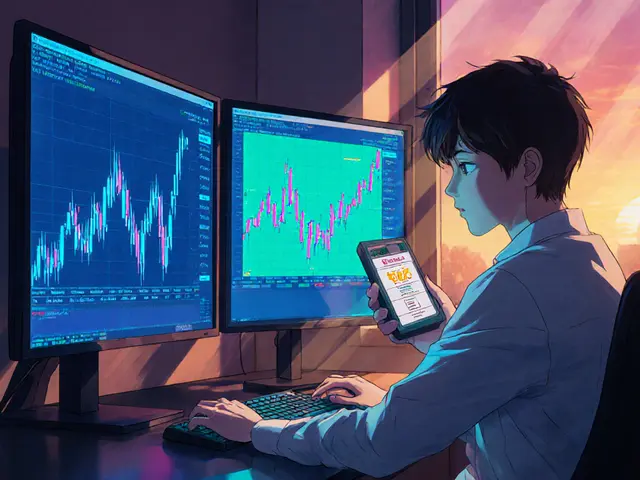Crypto Trading Pair Volume Analyzer
Analysis Results
Volume Comparison
Market Capitalization
Larger market cap tokens attract more traders due to perceived stability and lower risk.
Liquidity Depth
Deep order books reduce slippage and price impact for large trades.
Institutional Participation
Institutions prefer pairs with predictable liquidity and tight spreads.
Trading Volume is a measure of how much of a cryptocurrency changes hands in a given time frame, typically 24hours. When you look at different crypto pairs on an exchange, you’ll notice some consistently churn out billions while others barely move a few million. The gap isn’t random - it’s driven by a mix of market size, liquidity, investor type, and where the pair is listed.
Quick Take
- Big market caps and deep liquidity pull the most traders.
- Institutional players gravitate toward pairs with clean order books.
- Low‑volume pairs suffer higher slippage and price impact.
- Volume spikes often flag news or large‑player activity.
- Understanding volume helps avoid false breakouts.
What Drives High Volume in a Pair?
First, the Cryptocurrency Pair is a two‑asset combination that traders buy and sell, like BTC/USDT or ETH/BTC. The bigger the combined market capitalization of the two assets, the larger the pool of potential participants. Markets like Bitcoin (BTC) and Ethereum (ETH) sit on the highest caps, so their pairs naturally attract more orders.
Second, Liquidity is a measure of how easily a token can be bought or sold without moving the price drastically. Exchanges with deep order books can absorb big trades, which keeps spreads tight and slippage low. Traders love that environment because it protects their execution costs.
Third, the presence of Institutional Investor activity adds a volume boost. Fund managers, hedge funds, and corporate treasuries require sizable, predictable liquidity. They tend to stick to well‑established pairs to avoid market impact, which in turn inflates the volume numbers.
Liquidity vs. Price Impact: The Numbers Behind the Noise
Imagine you want to sell $100,000 worth of a low‑volume altcoin. In a thin market, that order could shift the price 5-10% in a single minute, eroding your proceeds. In a high‑volume pair like BTC/USDT, the same $100,000 would barely move the price, often under 0.01%.
Research shows that the top five crypto pairs routinely generate more than $50billion in 24‑hour trading volume, while the next tier of 20‑odd pairs hover in the $200‑500million range. The disparity creates a feedback loop: deep liquidity attracts more traders, which then deepens liquidity further.
Case Study: Bitcoin vs. A New DeFi Token
During the July2021 rally, Bitcoin (BTC) averaged a 24‑hour volume of roughly $30billion on major exchanges. At the same time, the newly launched DeFi token XYZ, despite a strong community, struggled to break $50million in daily volume. The reasons were clear:
- Market cap: BTC’s market cap was over $600billion, XYZ’s was under $1billion.
- Exchange listings: BTC appears on every top‑tier exchange; XYZ was listed on a handful of niche platforms.
- Liquidity providers: Market‑making bots and institutional desks were active on BTC, whereas XYZ relied on a few community volunteers.
The outcome? BTC’s price moved smoothly with large orders, while XYZ saw erratic spikes and deep dips whenever a single whale entered the market.

How Exchanges Shape Volume Distribution
Not all Exchange platforms treat pairs equally. Major exchanges-Binance, Coinbase, Kraken-apply tighter listing standards, deeper market‑making contracts, and sophisticated volume‑tracking tools. Those standards pull in professional traders who need reliable execution.
Conversely, smaller or newer exchanges may list dozens of exotic pairs with minimal order‑book depth. While they offer variety, the same lack of liquidity can deter large players, keeping volume low. Some exchanges even delist pairs that fall below a threshold (often $5‑10million in 30‑day volume) to protect overall market health.
Volume Spikes: Signals, Not Noise
Sharp, short‑term volume jumps often precede big price moves. A sudden influx of buy orders can be traced to:
- Institutional fund allocations.
- Project announcements (partnerships, mainnet launches).
- Regulatory news that clears a legal gray area.
Traders use indicators like “On‑Balance Volume” or “Volume Weighted Average Price (VWAP)” to confirm whether a price breakout is backed by genuine buying pressure or just a transient hype burst.
Comparison: High‑Volume vs. Low‑Volume Pairs
| Attribute | High‑Volume Pairs | Low‑Volume Pairs |
|---|---|---|
| Avg 24‑h Volume | $10B+ (e.g., BTC/USDT, ETH/USDT) | $10‑$100M (e.g., obscure altcoin/USDT) |
| Liquidity Depth | Deep (tight spreads, <0.01% slippage for $100k trades) | Thin (spreads can exceed 1%, >5% slippage for $10k trades) |
| Typical Users | Institutions, high‑frequency traders, retail whales | Retail hobbyists, speculators, low‑cap project fans |
| Price Impact | Minimal, price moves smoothly with order flow | High, single orders can sway price dramatically |
| Example Pairs | BTC/USDT, ETH/BTC, BNB/USDT | XYZ/USDT, ABC/BTC, niche DeFi token pairs |
Practical Tips for Traders
1. **Check volume before entering a trade.** Use the exchange’s 24‑hour volume bar; a sudden rise often means news or a big player is active.
2. **Pair your analysis with price action.** A breakout on low volume can be a false signal; wait for volume to confirm.
3. **Beware of slippage on low‑volume pairs.** If you need to move more than 1% of a pair’s daily volume, expect price impact.
4. **Use VWAP for execution.** It gives you the average price you’d pay if you traded the entire day’s volume, helping you gauge fairness.
5. **Diversify across volume tiers.** While high‑volume pairs offer safety, a small allocation to promising low‑volume altcoins can boost returns-just keep risk controls tight.
Future Outlook: Will Volume Concentration Change?
As crypto matures, regulatory clarity and institutional adoption keep pouring money into the safest, most liquid pairs. However, breakthroughs-layer‑2 scaling, cross‑chain bridges, or breakthrough DeFi protocols-can shift attention to new tokens. When a project announces a major partnership or a mainnet launch, its pair’s volume can jump from single‑digit millions to billions within weeks.
In the next few years, expect the top‑three pairs (BTC/USDT, ETH/USDT, BNB/USDT) to retain the lion’s share of daily volume, but niche pairs tied to emerging ecosystems (e.g., Solana‑based stablecoins) may carve out noticeable slices if they solve real‑world problems.

Frequently Asked Questions
Why does Bitcoin always have higher volume than most altcoins?
Bitcoin’s massive market cap, universal exchange listings, and strong institutional demand create deep order books, which naturally generate the highest daily volume across the crypto market.
Can low‑volume pairs ever be profitable?
Yes, but they carry higher risk. Small‑cap tokens can spike dramatically when news hits, but the same thin liquidity can also cause severe price slippage and make it hard to exit positions.
How do I use volume spikes to spot large trader activity?
Watch for sudden, sustained increases in 24‑hour volume that coincide with price moves. Pair this with order‑book depth data or block‑explorer alerts for large wallet movements to confirm the presence of a whale.
What tools can help me monitor volume across multiple exchanges?
Platforms like CoinMarketCap, CryptoCompare, and most exchange APIs provide real‑time aggregated volume. Advanced traders also use charting tools (TradingView) with built‑in volume indicators and custom alerts.
Does higher volume guarantee a better trade?
Not automatically. Volume reduces slippage and confirms price moves, but you still need a solid strategy, risk management, and an understanding of why the volume is high (news, manipulation, etc.).












Katrinka Scribner
July 22, 2025 AT 10:34 AMWow, this post is sooo helpful! 😍 I’ve been trying to figure out why the BTC/USDT pair is always at the top, and now it makes sense. The market cap thing totally explains the hype, and the liquidity depth part is a lifesaver for my trades. Definitely gonna keep an eye on those volume spikes! 😂 Also, I always recive my best insights from articles like this, even if they’re a bit long. Thanks a lot! 🙃
Jacob Anderson
July 30, 2025 AT 20:41 PMOh, brilliant, another deep dive into something we all pretend to understand. Sarcasm aside, the “liquidity depth” point is basically “big fish eat small fish”, nothing new. But hey, at least the article didn’t miss the obvious “Bitcoin dominates”. 🙄
Oreoluwa Towoju
August 8, 2025 AT 06:47 AMKey takeaway: Look at the combined market cap of the pair; higher caps usually mean higher volume.
Amie Wilensky
August 16, 2025 AT 16:53 PMIndeed, the article captures the core dynamics; however, it could have delved deeper into exchange‑specific order‑book structures; additionally, the lack of quantitative thresholds feels like a missed opportunity; nonetheless, the premise remains sound.
Charles Banks Jr.
August 25, 2025 AT 03:00 AMSo basically, if you want to avoid getting slashed by a 5% price swing, stick to the big boys like BTC/USDT. Anything else is just a lottery ticket with a tiny chance of winning.
Ben Dwyer
September 2, 2025 AT 13:06 PMThat's a solid point. For anyone just starting out, focusing on high‑volume pairs can reduce unexpected slippage and improve trade execution.
Lindsay Miller
September 10, 2025 AT 23:12 PMI hear you, the volume thing can be confusing, but thinking about liquidity depth as how easy it is to buy or sell without moving the price can really help.
Waynne Kilian
September 19, 2025 AT 09:19 AMTotally agree, and sorry for any typoz-sometimes my brain goes fast when i write. It’s cool that the article also mentions how exchanges list pairs, because that really shapes the volume landscape.
Michael Wilkinson
September 27, 2025 AT 19:25 PMLook, if you’re not willing to trade the high‑volume pairs, you’re basically signing up for higher risk and worse fills.
Clint Barnett
October 6, 2025 AT 05:31 AMAbsolutely, the data is clear: top‑tier pairs like BTC/USDT dominate the charts, pulling in tens of billions daily, while obscure alt‑coin pairs linger in the single‑digit millions. This isn’t just a fluke; it’s a self‑reinforcing loop where deep liquidity attracts more traders, which in turn deepens liquidity even further. Moreover, institutional players bring massive order sizes that only the deepest order books can absorb without shocking the market. When you compare the order‑book depth of a high‑volume pair to that of a low‑volume token, the difference is like comparing the Grand Canyon to a backyard ditch. Even seasoned retail traders notice that slippage on low‑volume pairs can erode profits faster than a bad haircut. The article also correctly highlights exchange listing standards-big exchanges demand tighter spreads and robust market‑making, which funnels even more volume to those pairs. In contrast, niche exchanges with lax requirements may list dozens of exotic pairs, but they rarely see the whale traffic needed to sustain high volume. That’s why many of those exotic listings hover around the $10‑$100 million mark, as the table in the post illustrates. If you’re aiming for consistent execution, gravitating toward pairs with deep order books is a pragmatic strategy. And if you’re hunting for outsized gains, you might allocate a small slice to low‑volume gems, but only with strict risk controls. In short, volume isn’t just a number; it’s a proxy for market health, participant diversity, and execution quality. Remember, markets evolve, and a pair that is low‑volume today could become a star tomorrow if a major project launches on it. Keep an eye on news flow and developer activity, because those are the hidden catalysts behind sudden volume surges. Also, consider cross‑exchange arbitrage opportunities; sometimes a pair is thin on one exchange but deep on another, offering profit potential. Finally, always measure your own risk tolerance before chasing the hype of any volume spike. If you think volume guarantees profit, you might be living in a fairytale 📖.
Kate Nicholls
October 14, 2025 AT 15:37 PMThe piece missed mentioning that sometimes a sudden regulatory approval can catapult a previously low‑volume pair into the billions almost overnight.
Carl Robertson
October 23, 2025 AT 01:44 AMAh, the drama! Nothing like a regulatory whisper to send the volume charts into a frenzy, turning quiet tokens into overnight sensations while the rest of us scramble for a piece of the action.
Rajini N
October 31, 2025 AT 11:50 AMFor a practical approach, check the 24‑hour volume on multiple aggregators and compare it to the pair’s average over the past month; a consistent increase often signals growing interest, whereas a spike followed by a drop may be a short‑term hype.
Kate Roberge
November 8, 2025 AT 21:56 PMSure, but don’t forget that the hype machine can also be a trap; volume spikes sometimes hide pump‑and‑dump schemes, especially on low‑cap pairs that lack robust surveillance.
Jason Brittin
November 17, 2025 AT 08:03 AMAbsolutely, the data is clear: top‑tier pairs like BTC/USDT dominate the charts, pulling in tens of billions daily, while obscure alt‑coin pairs linger in the single‑digit millions. This isn’t just a fluke; it’s a self‑reinforcing loop where deep liquidity attracts more traders, which in turn deepens liquidity even further. Moreover, institutional players bring massive order sizes that only the deepest order books can absorb without shocking the market. When you compare the order‑book depth of a high‑volume pair to that of a low‑volume token, the difference is like comparing the Grand Canyon to a backyard ditch. Even seasoned retail traders notice that slippage on low‑volume pairs can erode profits faster than a bad haircut. The article also correctly highlights exchange listing standards-big exchanges demand tighter spreads and robust market‑making, which funnels even more volume to those pairs. In contrast, niche exchanges with lax requirements may list dozens of exotic pairs, but they rarely see the whale traffic needed to sustain high volume. That’s why many of those exotic listings hover around the $10‑$100 million mark, as the table in the post illustrates. If you’re aiming for consistent execution, gravitating toward pairs with deep order books is a pragmatic strategy. And if you’re hunting for outsized gains, you might allocate a small slice to low‑volume gems, but only with strict risk controls. In short, volume isn’t just a number; it’s a proxy for market health, participant diversity, and execution quality. Remember, markets evolve, and a pair that is low‑volume today could become a star tomorrow if a major project launches on it. Keep an eye on news flow and developer activity, because those are the hidden catalysts behind sudden volume surges. Also, consider cross‑exchange arbitrage opportunities; sometimes a pair is thin on one exchange but deep on another, offering profit potential. Finally, always measure your own risk tolerance before chasing the hype of any volume spike. If you think volume guarantees profit, you might be living in a fairytale 📖.
MD Razu
November 25, 2025 AT 18:09 PMFrom a philosophical standpoint, volume acts as the lifeblood of market ecosystems, a manifestation of collective intent that transcends mere numbers. One could argue that the very act of trading imbues price with meaning, and volume quantifies the intensity of that meaning. Yet we must caution against the hubris of treating volume as an infallible oracle; history is replete with epochs where high volume masked underlying fragility. Therefore, while we celebrate the robustness of deep liquidity, we should also remain vigilant, dissecting the motives behind each trade-whether they stem from genuine hedging or speculative frenzy. In this light, the article’s emphasis on institutional participation is apt, but the narrative would benefit from a deeper exploration of algorithmic trading’s impact on perceived volume. Ultimately, wisdom lies in recognizing volume as both a guide and a veil, illuminating pathways while concealing pitfalls.
VICKIE MALBRUE
December 4, 2025 AT 04:15 AMKeep learning and trade smart.